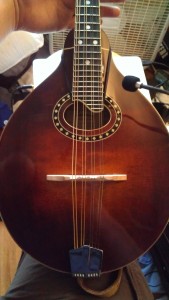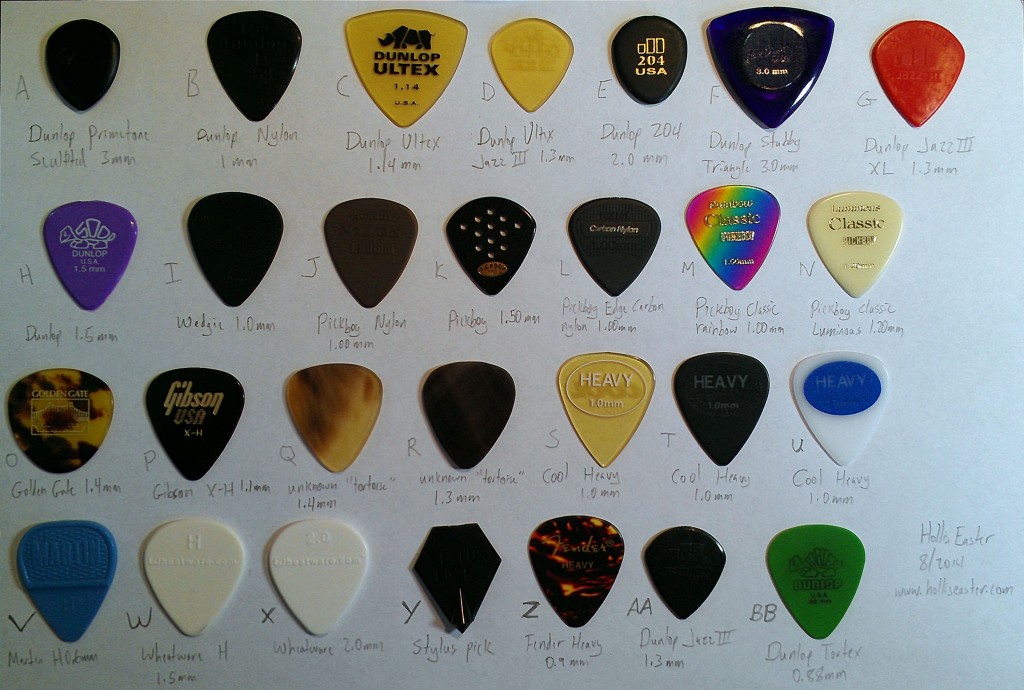When I did my post on making mandolin bridges, I wanted to make sound files available so readers could form their own opinions. Here’s the same thing for mandolin picks!
Mandolin players seem to love talking about picks. Which ones sound the best, which play fastest, how long they last, whether they’re worth the cost, which are hardest to drop, etc. Pick any vector of analysis and you’ll find people whose preferences span the whole thing.
It’s challenging to compare picks, though, because there are so many variables. Pick size, pick material, pick thickness, type of mandolin, type of strings, size of strings, microphone placement, bridge type, bridge and nut material, etc., and that’s just before we get to player-specific variables like how hard a player picks, what angle they use to approach the strings, how deeply they insert the pick, where along the strings they play, what style of music, etc. Compound those issues by using words (rather than sound samples) to describe the picks and it’s no wonder that picks are hard to talk about.
When I started learning to play guitar, someone gave me the advice to stop into every music store I passed and try to purchase one new kind of pick that I hadn’t used before. Picks are cheap, and this is a fun experiment to run over time. I’ve found some favorite picks this way–the Dunlop Primetone from Guitar Sam in Montpelier, VT; the funky tortoiseshell (that I think is made by Saga Music) from Dick’s Country Store Gun City & Music Oasis in Churubusco, NY; the Golden Gate picks from Dave Nichols of Custom Pearl Inlay in Whippleville, NY.
Experimental design
I want to present the picks without a lot of verbal analysis so that readers can form their own opinions. I’m going to reduce variables as much as possible:

- Instrument: Eastman MD-504 oval hole A-style mandolin with homemade maple 11-hole bridge with a ToneGard on the back
- Tune: Equinox, a jig that I wrote and regularly perform with Frost and Fire
- Microphone: K&K Silver Bullet cardioid electret condenser mic with phantom power
- Mic placement: gooseneck clipped to ToneGard and pointed at body just down from 14th fret and 1″ away from it
- Audio interface: Shure X2U XLR-to-USB converter
- DAW: Reaper 4.71 in 64-bit mode running on an Apple MacBook Pro with Retina (October 2013 model)
- Strings: D’Addario J74 (have been on the instrument about six weeks)
- Post-processing: All tracks saved as MP3 and normalized to 89 reference dB with MP3Gain Express 1.1.1. No other processing or effects.
This setup duplicates my normal on-stage setup except for the audio interface and DAW. Because the mic is mounted on the instrument, it should insulate against subtle changes due to position alteration. There was a lot of road traffic in front of my house today, so you’ll hear some cars going by in some samples—I guess you can think of that as a faithful test of normal playing conditions!
Each pick is labeled with an identification letter (A through BB); I also randomly assigned each pick a serial number to identify its sound samples and play order. There’s a link to the “answer key” at the bottom of the page.
The Picks

- A: Dunlop Primetone Sculpted 3 mm
- B: Dunlop Nylon 1 mm
- C: Dunlop Ultex 1.14 mm
- D: Dunlop Ultex Jazz III 1.3 mm
- E: Dunlop 204 2.0 mm
- F: Dunlop Stubby Triangle 3.0 mm
- G: Dunlop Jazz III XL 1.3 mm
- H: Dunlop 1.5 mm
- I: Wedgie 1.0 mm
- J: Pickboy Nylon 1.00 mm
- K: Pickboy 1.50 mm
- L: Pickboy Edge Carbon Nylon 1.00 mm
- M: Pickboy Classic Rainbow 1.00 mm
- N: Pickboy Classic Luminous 1.00 mm
- O: Golden Gate mandolin 1.4 mm
- P: Gibson USA X-H 1.1 mm
- Q: Unknown (Saga?) “tortoiseshell” 1.4 mm
- R: Unknown (Saga?) “tortoiseshell” 1.3 mm
- S: Cool Heavy translucent yellow 1.0 mm
- T: Cool Heavy black 1.0 mm
- U: Cool Heavy white 1.0 mm
- V: Martin H 0.6 mm
- W: Wheatware H 1.5 mm
- X: Wheatware 2.0 mm
- Y: Stylus Pick
- Z: Fender Heavy 0.9 mm
- AA: Dunlop Jazz III black 1.3 mm
- BB: Dunlop Tortex 0.88 mm
These are the picks I had when I did the test. If you’ve got a pick you’d love to hear added to the test, or if you find this comparison helpful and want to send thanks, send me some new picks to play with! If you find this really helpful, send me a Blue Chip or Wegen pick. 🙂 If you want to send me something, leave a message in the comments or ping me on Twitter and I’ll get in touch with my address. Thanks!
Sound samples
Normalized (all samples set to 89 dB with MP3Gain Express)
- Pick 1
- Pick 2
- Pick 3
- Pick 4
- Pick 5
- Pick 6
- Pick 7
- Pick 8
- Pick 9
- Pick 10
- Pick 11
- Pick 12
- Pick 13
- Pick 14
- Pick 15
- Pick 16
- Pick 17
- Pick 18
- Pick 19
- Pick 20
- Pick 21
- Pick 22
- Pick 23
- Pick 24
- Pick 25
- Pick 26
- Pick 27
- Pick 28
Discussion
Before you click to see the answer key, consider a few questions about the picks you’ve just heard.
- Do you notice similarities between picks of the same shape?
- Do you notice them between picks of the same size?
- What about between picks of the same material?
- What about between picks of the same brand?
- What about between picks of the same color?
- If you notice similarities, how would you describe them? If you notice differences, what words would you choose to explain what you’re hearing?
- How much would it surprise you to learn that I had recorded this tune 28 times in a row with the same pick? Would you believe me? What factors would make you believe or disbelieve that? Do you hear enough difference in the recordings to believe that something changed?
I actually did record it with 28 different picks, but I think that’s a key question: would you believe me if I told you they were all the same? If so, we can say that pick selection doesn’t matter tonally. If you hear differences, great! See which ones you prefer.
If you’re willing, write up your thoughts and post them as a comment before you click to see the answer key.
Raw sound files (not normalized)
- Raw pick 1
- Raw pick 2
- Raw pick 3
- Raw pick 4
- Raw pick 5
- Raw pick 6
- Raw pick 7
- Raw pick 8
- Raw pick 9
- Raw pick 10
- Raw pick 11
- Raw pick 12
- Raw pick 13
- Raw pick 14
- Raw pick 15
- Raw pick 16
- Raw pick 17
- Raw pick 18
- Raw pick 19
- Raw pick 20
- Raw pick 21
- Raw pick 22
- Raw pick 23
- Raw pick 24
- Raw pick 25
- Raw pick 26
- Raw pick 27
- Raw pick 28
Remember to leave your thoughts as a comment before you click to see the answers. Please also check out my article on making mandolin bridges at home!







You mentioned dropping your pick . I used to have that problem a lot, especially if my hands were sweaty. I was at a local hardware store one day waiting at the checkout counter and noticed colored , rubber key markers hanging on a rack. So I bought a pack of them and stuck my pick in one just like you would a key . Only dropped my pick once or twice in several years.
Hi, the “possibly made by Saga” picks are Saga “Mock Turtle” picks. They come in three shapes and currently list for $9.95 each. As tortoise is highly illegal to import and sell, these, clearly, are not. They are made of horn but I don’t know from what animal.
I’m a Saga dealer and have carried them for many years. We can buy them in 3-packs or by the dozen.